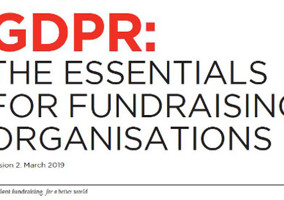All of us who work with people in potentially risky situations talk a lot about safeguarding – usually about things like policies, reporting processes and organisational culture.
We know that having a robust safeguarding policy is essential. Transparency and accountability in terms of reporting, taking action and learning lessons are essential too. But none of this helps if our beneficiaries don’t really understand what keeping safe means in the context of their everyday lives. It’s absolutely critical that we engage better with the people and communities that we work with.
Prevention is better than cure, as is early intervention. The six principles of adult safeguarding and the 5 Ps of child protection include prevention. So why is the current discourse just about things like whistleblowing and action taken after a situation has occurred? Why are we not talking about prevention, and about the implications of a transient duty of care? I think we’re in danger of locking the stable door after the horse has bolted. And of not learning from the experience.
The Advocacy Project has undertaken a consultation across care groups, community and faith groups to explore what local people understand by safeguarding and how to keep safe. This includes people with dementia, learning disabilities, physical and sensory disabilities, and mental health problems. We have applied the principles of coproduction to explore voice, rights, choice and empowerment in relation to safeguarding. We explored questions such as:
- What do you understand by being safe?
- What would you do if you felt that you (or someone you knew) wasn’t safe?
- What’s your experience of safeguarding?
In addition to this, we undertook a survey of around 100 patients in mental health wards in hospitals in London, exploring similar issues.
Shocking results
The results were a shock. People don’t seem to realise that many situations in which someone is not safe result from someone else’s actions due to a power imbalance or an abuse of power. Most people talked only about physical security, having locks on their doors and so on. Some people confused safety with not being lonely – people with pets felt safer than those without, even if the pet was a cat or a budgie.
There are also marked differences in the responses based on gender and sexual orientation, particularly in inpatient settings. Those identifying as female typically feel more vulnerable. We know from this and from our other work that people identifying as LGBTQ in mental health units are reluctant to disclose important information about their lives and their mental health to staff because they are afraid of discrimination and abuse – and scared of being locked away for longer than necessary because of this.
Financial abuse
Very few people identified the risk of financial abuse, even though we know from our advocacy work that this is an increasing problem. We came across cases where people talked about how professionals (such as support workers or care workers) are helping people manage their money. At times, we saw a worrying lack of clarity on professional boundaries, and little understanding of the need to do some due diligence before embarking on these kinds of arrangements. While many such provisions may be perfectly in order, as a sector we need to raise awareness of the need to think through the potential consequences of these sorts of decisions. And we need to do this without creating an environment of mutual distrust that makes people afraid to reach out.
Interestingly, people generally don’t think that the concepts and processes of safeguarding are anything to do with them or their lives. Many of those who’ve had experience of safeguarding thought it was an official process that happened to or around them. Those who hadn’t experienced safeguarding at first hand were even hazier about it. Some people said they’d contact a faith leader or cleric if they felt unsafe or thought someone else might be unsafe. Most respondents said that they’d contact a trusted person – a friend or neighbour.
Changing the discourse
So much for the principle of prevention and making safeguarding personal. We simply won’t be able to deliver on these principles unless we change the nature of our focus and discourse.
I’m not knocking staff in health and social care, in education or in the charity sector. I recognise the good work that health and social care professionals and organisations do to keep people safe. People are trying hard to do the right things right. But we need to shift our focus and change the narrative – the nature of our discourse. We all need to take steps to increase the understanding of our beneficiaries about keeping safe, and figure out what practical steps that we can each take to increase people’s agency and empowerment in relation to safeguarding. We also need to reflect on how this should inform our communications strategy, marketing material and awareness raising, as well as our practice.
The Advocacy Project has experience of safeguarding across all care groups in a variety of settings ranging from high-security forensic units to eating disorder units, children’s hospitals like Great Ormond Street and within communities. This experience has led us to focus on awareness and prevention in our approach to safeguarding. We are aware of our transient duty of care for citizens, residents and volunteers. We’ve delivered capacity-building training to increase people’s awareness of how to keep safe. We do this using a combination of approaches – objects of reference, mime, role play and written material (including easy read). It’s early days, but we’ve started to build peer support networks, where people who’ve participated in training are buddied with other people with a view to keeping each other safe. Building community capacity has to be the way forward, particularly given the ongoing pressure on health and social care budgets.
Safeguarding is embedded in our governance. The Advocacy Project’s board receives assurance on safeguarding, complaints and whistleblowing via a dashboard. We are vigilant for any sign of abuse of power. The HR, remuneration and policy committee maintains oversight of DBS checks and annual attendance at safeguarding training. Our staff survey explores whether people feel able to speak out about concerns and the results are reported to the board. We strive to create an environment in which people feel that it’s safe to speak out. We’re delighted that we’ve moved from a low of 20 per cent in 2016 to 78 per cent of staff in 2019 feeling able to speak up and challenge how things are done. We’re also reviewing our communications strategy and our safeguarding leaflets and posters in the light of the results of this survey and consultation work. As I’ve said before, we’re not perfect. But we do try hard.
We will continue building and augmenting the picture over time, and expect this work to continue over the next 12 months. We will publish a report with the findings and circulate this to those working in and with the sector. We’ll evaluate carefully the outcomes of the peer support network pilot projects, identify what works and build on it.
Collaborative approach
We’re keen for professionals who share our vision to help us shape this work – contributing experiences, views and funding – so that together we can strengthen the focus on prevention in safeguarding and genuinely reduce the potential for harm and improve outcomes.
Our commissioners and funders appreciate the work we’re doing in building the capacity of local people to keep themselves and others safe. There are some real beacons of good practice – we’re delighted that agencies like the London Borough of Hackney have asked us to advise their commissioning team on how they can assess real-life practice in safeguarding as an integral part of procurement processes. This is in sharp contrast to the tick-box approach taken in many public sector procurements, where suppliers simply need to have a policy called safeguarding to be considered sufficiently robust. A pass/fail question in a tender about whether you have a safeguarding policy does not cut the mustard.
As a sector, we’ll never deliver on the prevention aspects of safeguarding unless we change the narrative and take a different approach. By building the awareness and the capacity of beneficiaries, piloting schemes like peer mentors for safeguarding, changing our communications strategies and materials, listening to people at most risk of harm and learning from them, we will be doing more of the right things in the right way. It will shape effective safeguarding practice moving forwards.
Judith Davey is chief executive of The Advocacy Project
Related articles
|












